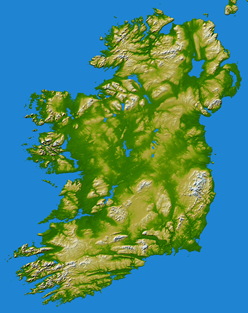Where We Are

Why Ireland is Ireland a Prime Site For Seaweed Production ?
Ireland is the most westerly country in the European Union Ireland is separated from the UK (and therefore, the rest of Europe) by the North Channel in the northeast and the Irish Sea to east. The west of Ireland is located on the wild-margins of the Atlantic coast, where its deep sea currents according to National Geographic Magazine “…keep winters and waters relatively mild and stable, a boon for marine life. …on the western side, animals, many at the extremes of their ranges, meet in clean temperate Atlantic waters that wash shores of varied rock types and topographies from exposed cliffs to sheltered coves. Habitats, as a result, are assorted and ample in the intertidal zone and on down the gently sloping shelf. Life explodes into every niche.” (f).
The island of Ireland occupies less than 85,000 sp. km. (approx. 32,500 sq. miles) and is located in the extreme north-west of the European continent lying between 51° and 55° north latitude and 5° and 10° west longitude. It’s greatest length 485 km (302 miles) and is 304 km (189 miles) at its greatest length. As a coastal nation Ireland possesses a long coastline compared to its surface area ð compare to Japan ð Ireland has a coastline 5,631 km (3,500 miles), which may well stretch to over 7,500 km including bays, inlets and estuaries.
The North Atlantic Drift is a powerful warm ocean current (c), and is one of the strongest currents known (d) directly hits Ireland before extending upwards to the Nordic counties and downwards to Spain and Portugal and beyond as the Canary current. This current is responsible for a milder climate than would otherwise be expected (b). This means that the west coast of Ireland around that of Munster where we are located, is bathed in some of the cleanest and clearest seas in Europe (e). The other significant benefit of this current is the nutrient rich waters that bathe the west coast of Ireland are responsible for the marked abundance of marine plant and animal life in this region. As a measure of the purity of the waters that abound Ireland and especially those around the west coast of Ireland, 78 blue flags were awarded to Ireland in 2008. The Blue Flag Scheme is a scheme administered by An Taisce here in Ireland and at European level by the Foundation for Environmental Education in Europe (FEEE). In order to receive a blue flag, a bathing site must maintain the highest standards of water quality as outlined by the EU, and meet stringent specified objectives that cover for example, water quality, environmental management of the beach area and environmental education (g).
The population density of the Republic is amongst the sparsest in Europe at 58 inhabitants per sq. km, compared to 244 and 349 in the UK and the Netherlands, repectively (a). This situation in addition to the fact that there Ireland does no possess any heavy industry, such as Iron and steel smelting, we do not generate power using nuclear power, there are no large population centres near the beeches where we harvest our sea vegetables.
In summary, Ireland is the least populated country in the European Union, and the west of Ireland is the least populated region in Ireland, this coupled with the fact that there is no chemical or heavy industry in this region means it has none of the if not, the cleanest and pollution free regions in Europe, ideal for the production and harvest of seaweeds.
(a) “Geography of Ireland”, by Professor William Nolan. © Government of Ireland (2009).
(b) “Encyclopedia of World Geography, The British Isles”, by Peter Haggett, Physical Geography (2002), PP. 900 – 907.
(c) "The Canary Current, Ocean Surface Currents”, by Joanna Gyory, Arthur J. Mariano, Edward H. Ryan (2007).
(d) “Gulf Stream”. © Economic Expert.com
(e) “Sea Angling in Ireland”, © Irish Fisheries Board. Retrieved 09/01/09
(f) “
(g) “Roles and Responsibilities, 2. Enivironmental Protection Agency”, © Environmental Protection Agency (2008)


